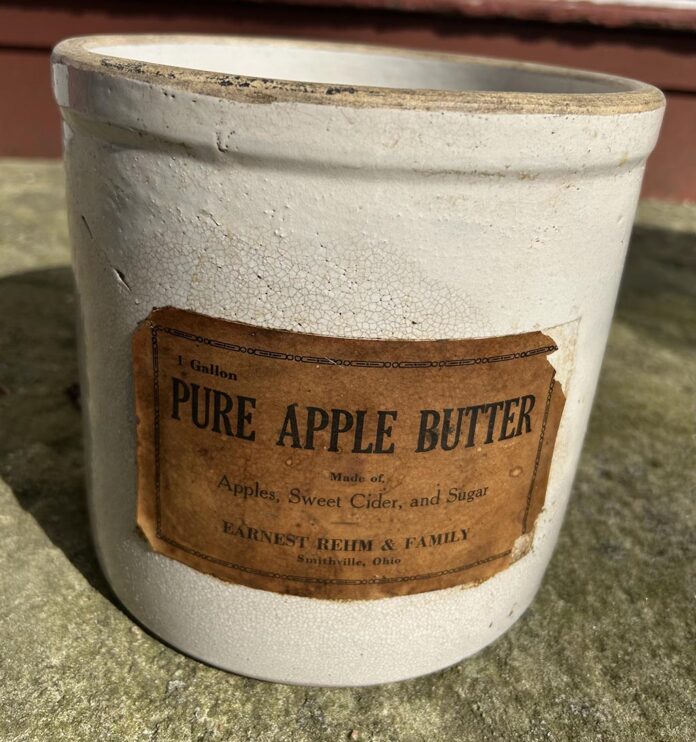
The merriment surrounding an apple butter-making party couldn’t extend too far into the evening because the work involved in the whole production started early – very early – the following morning. It had to so that the batch of apple butter in question could be finished off by evening. It wasn’t unusual for the apple butter stirring to get going around 5 a.m., even before sunrise.
As a first step, a substantial quantity of cider was dumped into the big copper kettle. Then the first logs were stacked underneath and the fire was ignited. If there was wind, a sheet of metal was positioned to block the breeze from blowing the heat from underneath the kettle. The metal also acted as a shield to protect the long line of stirrers from the heat of the fire and any sparks that might escape.
The right recipe

The initial pour of cider had to cook down to half volume from the heat below. Then it was time to add in the apples that had been so carefully peeled, cored and sectioned during the previous evening’s festivities. How many apples and how much cider? Well, that depends a lot on who you talk to and what their family tradition of apple butter making dictated.
Listening to the hearsay and reading what meager scholarly literature is available on the subject, it seems that an ideal ratio was something like three bushels of apples and two barrels of cider. Still, others contend that five bushels of apples should be added to 80 gallons of cider, which cooked seven hours for a 20-gallon batch.
Before the apples were put in, more cider had to be added to somewhat float them. The idea was to get the mixture of cider and apples up to within a few inches of the top of the kettle and allow it to cook down from there. At that point, the stirring began and would continue non-stop for the next 10 to 12 hours, or until the slices of apples broke down and attained the consistency of a thick applesauce or porridge. Some said the ideal mixture had to turn out “as thick as hasty pudding.”
Taking a turn

It was an unwritten rule that all attendees at the apple butter stirring — be they family, friends, curiosity seekers or just innocent bystanders — take a turn stirring with the long wooden paddle. The idea was to keep the mixture agitated at all times so that it didn’t burn or scorch. As the day went on and the mixture continued to thicken, the stirring became ever more difficult – or maybe it just felt that way after hours and hours.
While one person was stirring the kettle, other participants relaxed nearby, awaiting their turn. In addition to spinning yarns about the past or playing with the children who were present, participants also worked to prepare lunch. This was often done in a cast iron cauldron suspended from a tripod over a second fire not far from the apple butter kettle.
When lunch was served, everyone ate near the apple butter kettle since the fire had to be constantly replenished. In the early afternoon the ladies who were present retired to the kitchen to make up a batch of homemade bread or biscuits. We’ll get back to that shortly.
As the afternoon turned into evening, it was time to start to think about finishing up the batch by adding in sugar and those secret spices and seasonings such as cinnamon — probably the most popular — cloves and sassafras, which were part of closely guarded family recipes. Sugar was added to taste, but it was not unusual for quite a few pounds of sugar to be poured into the kettle and dissolved. Some families also liked to add bags of peppermint candies to give the mixture some brighter color and a little extra snap of flavor.
Between 10 and 12 hours after it was kindled, the fire was allowed to go out and the seemingly endless stirring ceased. It was now time to get the hot mixture into the earthenware crocks that had been washed and readied the previous evening. The hot apple butter was ladled from the cauldron into the waiting containers of a variety of sizes and shapes. Then cloth or brown paper was tied over the top of each to preserve the product therein. It is said that apple butter stored this way would keep for 25 years and beyond. While the moisture eventually evaporated, the mixture could readily be reconstituted.
After the crocks were all filled and divided among the participating families, it was time to remove from the kettle the remaining apple butter that had evaded the ladle. So, how was that task accomplished? Remember when the women in the group headed to the kitchen to make fresh bread and biscuits? Well, those were brought out — still warm from the oven — sliced and distributed to the participants who used them to sop up the rest of the apple butter so none would be wasted. They knew, as do today’s aficionados, that there is simply no better way to enjoy apple butter than on warm homemade bread and biscuits. Period.












